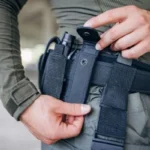If you carry a gun, whether it is for personal protection or as part of your job, then having the right gun belt is essential. A good gun belt should provide stability and support for your weapon while allowing easy access when needed. But with so many different options on the market, how do you know which one is right for you? So first, let’s find out What Is The Best Gun Belt For Concealed Carry.
The best gun belt for concealed carry is subjective, but popular choices include the Blue Alpha Gear Low Profile EDC Belt, Volund Gearworks G-Hook Belt, and the Beltman Horsehide Belt. These belts offer sturdy construction, adjustable sizing, and excellent support for carrying concealed firearms. Ultimately, the ideal belt depends on individual preferences and needs.
What Is The Best Gun Belt For Concealed Carry | Things To Consider

Material Matters
The material of your gun belt will have a significant impact on its performance. Look for belts made from high-quality leather or nylon webbing—these materials will ensure that your belt can stand up to wear and tear without sagging or stretching over time. Leather belts are more comfortable than nylon but are also more expensive and require more maintenance.
Nylon belts are generally more affordable but don’t provide as much support as leather belts. Ultimately, it comes down to personal preference—makes sure that whatever material you choose is strong enough to support the weight of your weapon and gear.
Buckle Type
When it comes to buckles, there are two main types: steel snap and plastic quick-release. Steel snaps offer superior durability and security, but they can be difficult to open quickly if you need quick access to your weapon in an emergency.
Plastic quick-release buckles are easier to open but may not be as secure as steel snaps. But, again, this comes down to personal preference—ensure that whatever type of buckle you choose is durable enough for daily use.
Also Read: 5 Best Tactical Gun Belt To Handle Tactical Situations
Stitching Quality
The quality of the stitching on your gun belt will determine how well it stands up over time. Look for double-stitched seams that run around the entire edge of the belt instead of single-stitched seams that only run along one side of the belt—double-stitched seams offer superior strength and durability compared to single-stitched seams.
Additionally, inspect the stitching closely; any loose threads or weak spots could lead to an unexpected failure when carrying heavy loads like firearms or extra magazines.
Durability
When selecting a concealed carry belt, it is essential to look at its durability. The last thing you want is your gun belt to start sagging or slipping after only a few months or years of use.
Look for gun belts made of stiff, durable materials like heavy-duty leather or nylon webbing that won’t stretch out with time. If possible, try on different models before purchasing to get an idea of which material works best with your body type and daily activities.
Width and Thickness
The width and thickness of your gun belt should be considered when choosing the right one for concealed carry. A broad and thick gun belt will provide more support than a thin one, ensuring your firearm stays secure no matter how active you are throughout the day.
A good rule of thumb is to choose a gun belt at most minuscule 1 ½ inches wide and ¼ inch thick; this will ensure that your holster stays firmly secured while also providing enough support for other accessories, such as magazine pouches or flashlights.
Also Read: How To Put On A Plastic Tactical Gun Belt?
Do I Need A Special Belt For Concealed Carry?
If you’re considering concealed carry, the good news is that you don’t need a special belt. Many holsters rely on your existing belt to provide retention, whether you go with an IWB, OWB, or shoulder holster setup.
Of course, if you want a belt specifically designed for carrying, they are available on the market. These belts are usually broader and thicker than regular leather or cloth belts, providing extra support and making them more comfortable over extended periods of wear.
The thick and stiff construction prevents belt sag and keeps your handgun in place so it won’t print through light clothing. Ultimately, whether you need a special belt for concealed carry will depend on what kind of holster setup works best for your lifestyle.
Also Read: Do I Need A Gun Belt?
Bottom Line:
So, What Is The Best Gun Belt For Concealed Carry? Choosing the right gun belt can make all the difference when carrying a firearm safely and securely daily. The key is finding a balance between comfort and security—look for belts made from high-quality materials with durable buckles and strong stitching so you can trust your gear in any situation. Keep these tips in mind when shopping for a new gun belt, and you’ll be sure to find one that fits all your needs!



